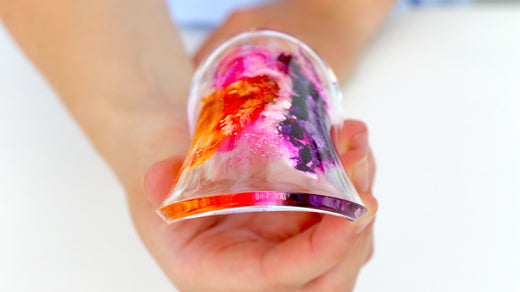Working with ArtResin is simple: measure, mix, pour, wait—and you’ll be rewarded with a beautiful, hard, glass-like finish on your work.

💡 Check out our blog on how to measure, mix & pour resin correctly!
Occasionally, you may find that your cured resin isn’t as solid as expected—it may even bend. Knowing why this happens and how to fix it is important for getting the best results with your resin projects.
What causes resin to cure soft?
| Cause | Description | Solution |
|---|---|---|
| Insufficient Cure Time | Epoxy resin may feel flexible if it hasn't fully cured. Initial curing can take 24 hours, but full hardness may require several days. | Allow the resin to cure for at least 3–7 days to achieve full hardness. Ensure the curing environment maintains the recommended temperature. |
| Thin Pour | Thin layers of resin (less than 1/3 inch) may remain flexible, especially without a supportive substrate. | Pour resin in layers of 1/3 inch or more. Use a sturdy backing material to provide support for thin pours. |
| Inaccurate Measuring | Deviating from the recommended resin-to-hardener ratio disrupts the chemical reaction, leading to improper curing. | Measure resin and hardener precisely according to the manufacturer's instructions, typically by volume. |
| Under Mixing | Inadequate mixing can result in uncured spots, causing the resin to remain soft or sticky. | Mix the resin and hardener thoroughly for at least 3 minutes, ensuring a uniform mixture. |
| Excessive Colorant | Adding more than the recommended amount of pigment or dye can interfere with the curing process. | Limit colorants to no more than 6% of the total resin mixture to maintain proper curing. |
| Low Ambient Temperature | Curing in a cold environment can slow down or inhibit the curing process, resulting in flexible resin. | Maintain a workspace temperature between 70–80°F (21–27°C) during mixing and curing. |
| High Humidity | Excess moisture in the air can affect the curing process, leading to soft or sticky resin. | Work in a controlled environment with low humidity to ensure proper curing. |
Let’s talk about the WHY. There are several reasons and factors why resin can cure soft.
1. Short Cure Time
If your resin feels flexible, it’s usually because it needs more time to cure. After 24 hours, ArtResin will reach about 95% of its final hardness. However, if you try to bend or move it before this 24-hour mark, it’s likely to feel soft or bendable. For a fully cured finish, we recommend waiting 3–5 days for the resin to reach 100% hardness.
💡 Read our blog How To Make Resin Cure Faster.

2. Thin Pour
Many art projects call for a thin layer of resin. While ArtResin will cure with thinner pours, layers less than ⅓" may still have some flexibility until fully cured, especially if there isn't any backing or substrate. If your resin is bendy, allow more time to cure or try adding additional layers.
3. Inaccurate Measuring
ArtResin is a simple 1:1 mixing ratio by volume —not weight— and keeping this balance is essential for a successful pour. Adding too much of either resin or hardener disrupts the chemical reaction, which can prevent proper curing. Although the mixture may harden, an incorrect ratio often results in resin that bends or doesn’t fully set.

4. Under Mixing
Mixing the resin and hardener thoroughly is crucial for proper curing. Stir them together for at least 3 minutes to ensure they’re fully combined. If the resin isn’t mixed well, it may harden but won’t cure completely, often resulting in a pliable finish.
5. Too Much Colorant
Adding too much colorant or pigment can disrupt the resin’s balance. While tinting resin creates beautiful effects, adding more than 6% of the total volume may soften the final cure.

Now, how can you fix flexible resin?
The good news is that this can often be an easy fix—it just takes a bit of patience. Simply let the resin sit for another 2 to 7 days to fully cure. This extra curing time should harden your piece and prevent any bending.
If your piece is on the thinner side, a slight bend may be inevitable, as we recommend a thickness of at least ⅓". Using a sturdy base like a bezel or a panel will help reinforce the strength of the resin.

If inaccurate measuring, under mixing, or excess colorants has affected the cure, the resin may not harden further. A possible fix is to carefully measure and mix another batch of ArtResin to pour over the bendy piece, to add strength and support.
So fear not! ArtResin Epoxy Resin Products are very forgiving. There’s always a reason for what’s happening, and in most cases, a solution.
In fact, soft resin can have its advantages: many artists use the 24-hour cure time to their advantage in order to shape and mold their resin mixtures into a unique design before it fully hardens. Bendy resin can have its advantages.

So looking forward, here is a cheat sheet of things to remember in order to prevent bendy resin from happening again.
7 Steps to Prevent This Issue:
If your resin piece is still flexible after the recommended curing time, try these steps to resolve the issue.
-
Measure the correct amount of resin and hardener: Always stick to the recommended resin-to-hardener ratio. Using incorrect amounts of either component can disrupt the curing process and lead to flexibility issues.
-
Mix thoroughly for at least 3 minutes.
-
Pour in layers of ⅓" or more.
-
Use a substrate for thin pours.
-
Limit colorants and pigments to 6 %.
-
Allow your artwork to fully cure (at least 3-5 days).
-
Maintain ideal temperature: Ensure both your workspace and resin are slightly warmer than standard room temperature before mixing. 75-85°F or 24-30°C is ideal. Use a space heater or work in a warmer room if necessary.
And that’s it! Be sure to check out our blog How To Shape Resin that shows how you can bend and shape resin while still achieving a hard finish. If you have any questions or want to share your experience fixing this issue, feel free to leave a comment below. As always, be creative and have fun!
Do you want to learn more about troubleshooting epoxy resin? Read our blogs below:
- ArtResin’s Troubleshooting Guide
- Tips To Prevent Bubbles
- Can I Fix Small Imperfections In My Resin?
- Is It Possible To Overstir My ArtResin?
- How Do I Remove Epoxy Resin Drips?
- Is It Possible To Over Torch My ArtResin?
- My Epoxy Resin Is Not Hardening
- How To Fix Soft, Sticky Spots In My Resin
- How Can I Avoid Getting Dimples In My Epoxy Resin?
- How Can I Get Rid Of Bubbles In My Cured Resin?
- Tips To Keep Dust Out Of Your Resin Art
- How Can I Deal With Epoxy Resin Drips After They've Dried?
- What Happens If I Over Torch Resin?
- Why Does My Resin Look Milky?
- Why Is My Epoxy Resin Still Sticky?
- Why Are There Bare Spots In My Cured Resin?
- What Does Silicone Do To Resin?
ArtResin: The Original Epoxy For Resin Art.







